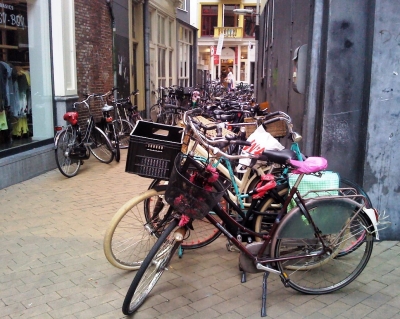Walking a Cycling City
Groningen in the north-east of the Netherlands is a biking city. While cycling is an extremely common in the country, the shear dominance of bikes and cycling in this city is noteworthy. I was in the city for the Fourth International Emotional Geographies Conference and we were all struck by the role of bikes in daily life. Indeed, we were informed that there were 2.4 bikes per head of population in the city.
It was both fascinating and inspiring to see what a city can be like when bikes become the prevalent form of transport instead of cars. As a pedestrian it took a little getting used to, bikes whizzing by, people of all ages and backgrounds pedalling and stationary bikes occupying considerable space. I found myself having to get good at estimate how gaps between cyclists for crossing the ‘roads’. I resisted to urge to rent a bike myself, instead deciding to explore the place at my walking pace.
It’s nice to think that cities can be like this, but also unfortunate the it is unlikely that such a culture would ever come to be in Ireland. Although most of our cities are small enough to be cycling cities, it would require a large scale shift in thinking and considerable official support in terms of infrastructure, not least large investments in biking parking spaces and proper bike lanes – completely separate to the main road by reducing car lanes or making streets one way. While any such changes are a while off we always have Groningen!

A bike lane to one of the main squares Vismarkt. Although these lanes are occasionally used by cars, it is dominated by the flow of thousands of bikes daily. ES: Una ciclovía a una de las principales plazas de Vismarkt. Aunque estas vías son usadas por autos ocasionalmente, están dominadas diariamente por el flujo de bicicletas.

Bikes packed into a laneway off Grote Markt. Bikes are parked every where here, there are marked out areas on all footpaths and public buildings (such as the University and Train Station) have the facilities to park hundreds of bikes. ES: Bicicletas amontonadas en una vía adyacente al Grote Markt. Las bicicletas están estacionadas en todas partes en este lugar, hay áreas demarcadas en todas las aceras y edificios públicos (como la Universidad y la Estación de Tren) tienen instalaciones para estacionar cientos de bicicletas.
A short video taken on my phone showing the dominant bike culture by capturing the flows and interactions at a junction on the Grote Markt. ES: Un video corto filmado con mi teléfono mostrando el dominio de la cultura ciclista, capturando los flujos e interacciones en un cruce en Grote Markt.
Spanish Version
Groninga, al noreste de los Países Bajos, es una ciudad en bicicleta. Si bien andar en bicicleta es bastante común en el país, la prevalencia de las bicicletas y el ciclismo en esta ciudad son notables. Estuve en la ciudad para la Cuarta Conferencia Internacional de Geografías Emocionales y todos nos sorprendimos por el rol de las bicicletas en la vida diaria de las personas. De hecho, nos informaron que hay 2.4 bicicletas por persona en la ciudad.
Fue facinante e inspirador ver cómo puede ser una ciudad cuando las bicicletas se convierten en la forma principal de transporte en vez de los autos. Como peatón acostumbrarse toma tiempo a las bicicletas pasando raudas a nuestro lado, gente de todas las edades y status pedaleando, y también tantas bicicletas estacionadas ocupando espacios considerables. Me encontré a mi mismo mejorando mi habilidad de estimar los espacios entre bicicletas para poder cruzar las “calles”. Resistí la tentación de alquilar una bicicleta, y decidí explorar el lugar a mi propio ritmo.
Es lindo pensar que las ciudades pueden ser así, desafortunadamente es poco probable que esta cultura se instale en Irlanda. A pesar de que la mayoría de nuestras ciudades son lo suficientemente pequeñas para ser ciudades en bicicleta, requeriría un gran cambio en nuestra forma de pensar y considerable apoyo del gobierno en términos de infraestructura, por lo menos grandes inversiones en espacios para estacionar las bicicletas y ciclovías apropiadas – completamente separadas de las calles principales o haciéndolas calles de un sólo sentido. Si bien estos cambios aún tomen un poco de tiempo, siempre tendremos a Groninga!